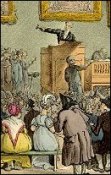 Our new "Going Once... Going Twice..." catalog of antique auction catalogs is in the mail, and available for viewing on our website. If you'd like a printed copy, please let us know.
Our new "Going Once... Going Twice..." catalog of antique auction catalogs is in the mail, and available for viewing on our website. If you'd like a printed copy, please let us know.One of the catalogs featured was Parke-Bernet's Catalog #1, and there's a story to go with it...
Wall Street millionaire Jay F. Carlisle and his wife, Mary (Pinkerton) Carlisle, daughter of the founder of the famous detective firm, collected English and French furniture, sporting art, Flemish tapestries, silver, glass, oriental rugs & art, Georgian silver, Staffordshire and other porcelains. Their home, 'Rosemary', was, according to Harry Havemeyer in “Along the Great South Bay”- “one of the showplaces of the East and was decorated with the very finest antique furnishings in the most tasteful way."
Wesley Towner, in “The Elegant Auctioneers”, says that Jay Carlisle “had many friends, belonged to many clubs...his pallbearers included Walter P. Chrysler and other notables. The furnishings at ‘Rosemary’ -the snuff boxes and ivory miniatures, the sporting prints and tinkling wine glasses- had an aura all their own”.
The Carlisles died within a short time of each other and in early 1938 their estate needed to be sold, which was a good thing for Hiram Parke and Otto Bernet. Just a short time before they had, with about 40 loyal employees, walked out of the American Art Association-Anderson Galleries after a power struggle with its owners, and set up on their own in borrowed rooms. Mortgaging homes and life insurance policies, borrowing from former clients and fellow dealers and throwing in their life savings, the small group needed a magnificent event for their first sale-
“It was clear”, Towner relates, “that Providence had dispatched the Carlisle’s for Parke’s convenience, and just in the nick of time. Hyam went out to Islip with three teams of cataloguers. Stenographers worked double shifts, driven by the exigencies of the cause. Photographers took pictures by day and developed them by night, for the house was jammed with small objects -rare Staffordshire, the bronze cowboys of Frederic Remington, a singing bird fashioned out of silver. The mere numbering and sorting were prodigious labors, for there were, when all counted, four thousand items. And yet, somehow, the entire catalogue was turned out in a week, and without an error.”
Nine thousand people previewed the sale, and the day of the auction the 400 seats in the hall were filled an hour before bidding began. The sale was, needless to say, a roaring success, and the auction firm Parke-Bernet was launched.
Back at 'Rosemary', once the auction was over and the contents dispersed, the house itself was torn down a few months later. The venerable American Art Association-Anderson Galleries, bereft of Major Parke and Otto Bernet, survived a few months longer than that, but not many. Parke-Bernet would go on to become America's premier auction house for decades, until its eventual "partnering" with, and final sale to, Sotheby's.

No comments:
Post a Comment